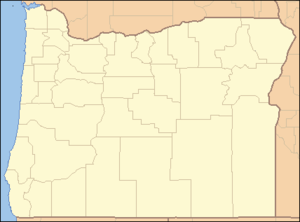New River (Oregon)
| New River | |
|
The New River in June
|
|
| Country | United States |
|---|---|
| State | Oregon |
| County | Curry and Coos |
| Source | Confluence of Floras Lake outlet with Floras Creek |
| - location | near Langlois, Curry County |
| - elevation | 13 ft (4 m) |
| - coordinates | 42°54′48″N 124°29′51″W / 42.91333°N 124.49750°W |
| Mouth | Pacific Ocean |
| - location | south of Bandon State Natural Area, Coos County |
| - elevation | 3 ft (1 m) |
| - coordinates | 43°00′02″N 124°27′30″W / 43.00056°N 124.45833°WCoordinates: 43°00′02″N 124°27′30″W / 43.00056°N 124.45833°W |
| Length | 8 mi (13 km) |
| Basin | 126 sq mi (326 km2) |
| Discharge | |
| - average | 350 cu ft/s (10 m3/s) |
The New River is a stream, about 8 miles (13 km) long, on the southern coast of the U.S. state of Oregon. It begins slightly north of Floras Lake, at the confluence of the lake outlet and Floras Creek, and runs north behind a foredune until entering the Pacific Ocean between Bandon and Port Orford.
The river's name stems from its creation in 1890, when sand blocked the outlet from Floras Lake during a heavy storm, and the resulting flood created a new channel behind the foredune. The water from 21-mile (34 km) Floras Creek also flows down the new channel. The river loses only 10 feet (3 m) in elevation between source and mouth.
Evidence suggests that as early as 8,000 years ago, long before the New River existed, ancestors of the Siletz and Coquille peoples lived here in large villages near an estuary. About 300 years ago a 30-foot (9 m) tsunami destroyed the estuary and altered the landscape. After the catastrophe, blowing sand blocked streams, creating wetlands behind the dunes.
The area near the river, between Bandon to the north and Cape Blanco to the south, includes many state, federal, and county parks, recreation areas, and wildlife sanctuaries. Among those are the New River Area of Critical Environmental Concern (ACEC), overseen by the Bureau of Land Management. The BLM encourages public uses of the 1,200-acre (490 ha) site at the same time it works to protect habitat for native plants, birds, animals, and fish.
European beachgrass, an invasive species, was planted here in the early 20th century to stabilize the dunes, which can grow to 30 feet (9 m) high. The dunes kept the river in its new channel but displaced native vegetation such as sand verbena and otherwise altered the habitats used by birds and other life forms.
...
Wikipedia


